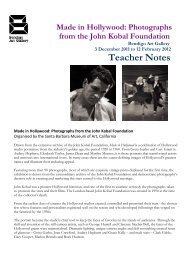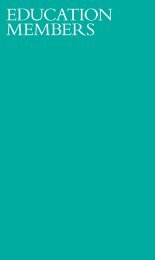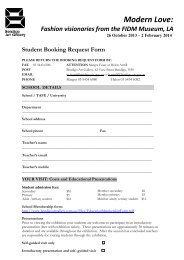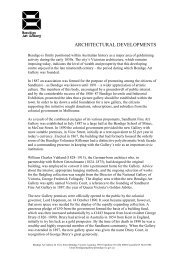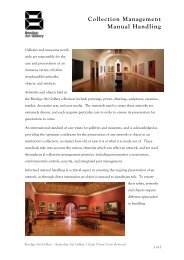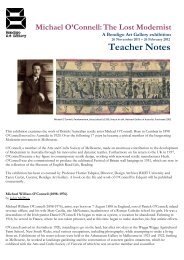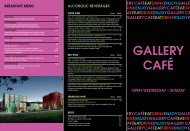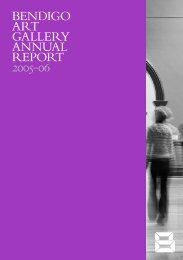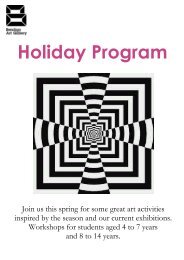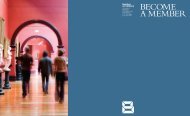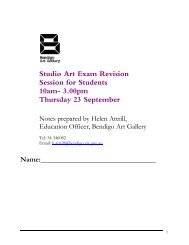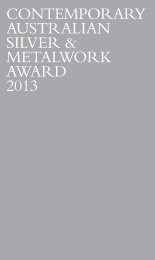English pd notes - Bendigo Art Gallery
English pd notes - Bendigo Art Gallery
English pd notes - Bendigo Art Gallery
You also want an ePaper? Increase the reach of your titles
YUMPU automatically turns print PDFs into web optimized ePapers that Google loves.
<strong>English</strong>, <strong>Art</strong> and Literacy<br />
using <strong>Bendigo</strong> <strong>Art</strong> <strong>Gallery</strong><br />
as a resource in <strong>English</strong><br />
Professional Learning for <strong>English</strong> teachers<br />
3.45- 5.30pm Wednesday 21 November<br />
Notes prepared by Helen Attrill, Education Officer, <strong>Bendigo</strong> <strong>Art</strong> <strong>Gallery</strong><br />
Tel: 54 346082<br />
Email: h.attrill@bendigo.vic.gov.au<br />
W: www.bendigoartgallery.com.au
Introduction:<br />
Frequently asked questions about <strong>Bendigo</strong> <strong>Art</strong> <strong>Gallery</strong> education service<br />
What can the gallery offer VCE <strong>English</strong> teachers and students?<br />
<strong>Bendigo</strong> <strong>Art</strong> <strong>Gallery</strong> runs an exciting program of exhibitions every year in addition to the display of the<br />
permanent collection. As a public art gallery, school groups are welcome and encouraged to visit.<br />
What does it cost to bring students to the gallery?<br />
Most education tours and activities are free for school members ($3.50 per student for non-members).<br />
How is the gallery relevant to <strong>English</strong> students? What if I know nothing about art?<br />
<strong>Bendigo</strong> <strong>Art</strong> <strong>Gallery</strong> runs exhibitions that focus on a range of themes particularly stimulating for<br />
creative writing, issues or a review or argumentative nature; the open ended nature of art in <strong>English</strong><br />
makes it relevant to anyone, not only those with an art education.<br />
When is the Education Officer available for tours?<br />
There are two Education Officers who work part time at the <strong>Gallery</strong>. 2013 hours are still being<br />
negotiated.<br />
How long is a tour?<br />
It’s up to you; it could be a 10-20 minute introductory tour or an in-depth 45 minute – 1 hour tour<br />
Are there any rules for students in the gallery?<br />
Yes<br />
• Please explain to students that it is important not to touch any artworks.<br />
• Students must use pencils rather than pens and it is recommended that they bring a book or folder<br />
to rest paper on. Drawing boards and grey-lead pencils are available for loan at reception.<br />
• Students must leave their bags at reception; no food or drink in the gallery<br />
• No photography or recording/filming is allowed as many artworks are under strict copyright<br />
conditions; sometimes allowances are made if a student writes to the gallery for permission.<br />
Who is allowed to go to the gallery?<br />
The gallery is open to everyone; entry is now free; students can return at weekends and can invite<br />
friends. The gallery is open from 10am-5pm daily.<br />
Housekeeping:<br />
To book a tour with Helen, please contact her at the gallery: tel: 5434 6082 or email:<br />
h.attrill@bendigo.vic.gov.au ); if your session is a self-tour, you can telephone the gallery directly on 54<br />
346088 or email the gallery: bendigoartgallery@bendigo.vic.gov.au .<br />
2
Selected artworks on display 2012-13<br />
Del Kathryn BARTON<br />
Australia 1972<br />
i ate the rainbow up … … …<br />
2008<br />
acrylic, gouache, watercolour<br />
and ink on canvas<br />
The Gift of Grace and Alec Craig,<br />
<strong>Bendigo</strong>, Victoria 2009 2009.2<br />
Del Kathryn Barton explores the themes of figuration, fecundity, nurturing and life in her highly<br />
detailed paintings and sculptures. Many of her artworks are deeply personal, drawing on her feelings as<br />
a mother of two and her childhood spent on an agora goat farm. Barton’s work combines traditional<br />
painting techniques with contemporary design and illustrative styles and she is renowned for her<br />
collaborative work with the Australian Fashion label Romance was Born.<br />
In Postmodern style, her paintings appear to draw from a range of influences, including the decorative<br />
and suggestively sexual element in the paintings of Gustave Klimt, the patterning of Japanese artist<br />
Yayoi Kasuma, Indian miniatures and Aboriginal dot painting; Tibetan Mandalas, the strange but<br />
cartoon-like figures of outside artist William Darger, the plan view of the figure used by Egon Schiele,<br />
but the one she identifies with the most is British artist Chris Ofili, renowned sensationally for his<br />
highly decorative black Madonna paintings using elephant dung.<br />
Barton’s painting i ate the rainbow up … … …is similar to her Archibald Prize winning work You are what<br />
is most beautiful about me, a self portrait with Kell and Arella, in the use of the crowded composition and<br />
nurturing figures. In i ate the rainbow up……; the children are replaced with two female figures, using the<br />
decorative element of a multicoloured scarf to bind them together. The theme of relationships is<br />
emphasised with the unifying lines of the scarf and the consistent patterned background, this time with<br />
dots and stars, suggesting a never ending cosmos.<br />
Del Kathryn BARTON<br />
Australia 1972<br />
i ate the rainbow up … … …<br />
2008<br />
acrylic, gouache, watercolour<br />
and ink on canvas<br />
The Gift of Grace and Alec Craig,<br />
<strong>Bendigo</strong>, Victoria 2009<br />
3
Paddy BEDFORD<br />
Australia 1922–2007<br />
Yoowangeny – Mud Springs<br />
2005<br />
natural earth pigments and synthetic binder on linen<br />
The Gift of Grace and Alec Craig, <strong>Bendigo</strong> Victoria 2011 2001.34<br />
Bedford was a senior law man of the Gija people of the Kimberly region of Western Australia. His<br />
paintings relate the narratives of his mother’s and father’s country, combining the Dreaming stories of<br />
the cockatoo, bush turkey and emu with the topography of the land he regularly traversed as a<br />
stockman, including rivers, roads, rocks and waterholes.<br />
Born around 1922 on Bedford Downs Station in the remote East Kimberley region of Western<br />
Australia, Paddy Bedford began painting on canvas and board in 1998 and his artistic practice since<br />
then was remarkable, prolific and consistently innovative and is reflected in his selection as one of only<br />
eight Indigenous Australian artists to create a site-specific work for the Quai Branly Museum in Paris. A<br />
senior lawman of the Gija people, he painted as part of ceremony all his life, and brought this wealth of<br />
symbolic, historical and technical knowledge to bear on his art.<br />
Paddy Bedford’s paintings relate the narratives of his mother’s and father’s country, combining the<br />
Dreaming stories of the cockatoo, bush turkey and emu with the topography of the land he regularly<br />
traversed as a stockman, including rivers, roads, rocks and waterholes. The artist also created paintings<br />
based on accounts of the often brutal interaction between Aboriginal people and white settlers in the<br />
early years of the twentieth century, the repercussions of which continue in the Kimberley today.<br />
4
Andrew BROWNE<br />
Australia 1960<br />
Apparition<br />
2008<br />
oil on linen<br />
The Gift of Grace and Alec Craig<br />
<strong>Bendigo</strong> Victoria 2008 2008.10<br />
Andrew Browne is renown for his panoramic, often nocturnal landscape paintings which blur the<br />
boundaries between art and photography. He often describes his subject matter as “nature on the fringe<br />
of the city”. In contemporary Postmodern style, he investigates a range of landscape painting traditions<br />
from Northern Renaissance painters and their concern with humanity and nature through to the<br />
Modernist reduction of form.<br />
‘‘Apparition’ is a culmination of several years of paintings that have explored the nocturnal world, one<br />
that exists at the edge of our urban and rational experience. I have attempted to insert an uneasy and<br />
ambiguous presence into these paintings – one that conjures up highly suggestive forms derived from<br />
both direct observation and subsequent manipulation, to prompt reflections on both the natural and<br />
denatured place that we, as the observer, occupy.<br />
‘Apparition’ might be seen as representing a tangle of foliage and detritus that leans close to the viewer,<br />
partially obscuring an expansive dark space illuminated by distant blurred lights – signs of habitation.<br />
But look again and perhaps the visage of something more sinister emerges from this tangle – the face<br />
of a ghostly presence that looms forward to receive the flash of a camera or torch, the black void<br />
cloaking other threatening experiences and feelings.<br />
The intended ambiguity that exists within this image and others of the greater series of paintings<br />
encourages multiple readings, leaving the observer and the observed in a state of flux, shifting between<br />
the conscious and the unconscious, image and meaning.’<br />
Andrew Browne 7/8/08<br />
How has Browne conveyed a sense of ambiguity and mystery in his work?<br />
Andrew BROWNE<br />
Australia 1960<br />
Apparition<br />
2008<br />
oil on linen<br />
The Gift of Grace and Alec Craig <strong>Bendigo</strong> Victoria 2008<br />
5
Stephen BUSH<br />
Australia 1958<br />
The Lure of Paris #22<br />
2002<br />
oil on linen<br />
The Gift of Grace and Alec Craig<br />
<strong>Bendigo</strong> Victoria 2010 2010.9<br />
Stephen Bush is renown for his paintings which reference traditional European landscape painting<br />
traditions, juxtaposed with often incongruent subjects such as pot bellied stoves, food packages or<br />
Babar elephants.<br />
Aware of using aesthetics for either mood or Postmodern play, his recent paintings swing between lurid<br />
high-keyed colours and monochromatic tonal effects. In The Lure of Paris #22, Bush continues his<br />
playful investigation into the idea of image reproduction and Western cultural icons by producing more<br />
than 20 versions of the same painting, each one with only subtle differences.<br />
The image includes his trademark romantic sublime seaside landscape but with the figures of the<br />
elephant carton character Babar and friends, large and out of scale, appearing to climb the rocks. These<br />
paintings were produced using only black and white paint, appearing as early reproductions of artworks<br />
might.<br />
The use of the character Babar may on the surface may seem quirky or kitschy but the reasoning is<br />
multilayered. Bush, aware of the character of Babar from watching him on television with his child had<br />
found an abandoned, stuffed-toy version on a Geelong street. He then found out that Babar, after the<br />
death of his mother, was taken to France to be "civilised" before returning to Africa to "civilise" his<br />
fellow elephants. At this point, he knew Babar could be an ideal tool with which to explore Australia's<br />
post-colonial identity in painting.<br />
As a youth in the 60s and 70s, Bush was well versed in protest and questioning of western imperialism.<br />
He would have been aware of the protest and performance art of this period along with the quest for<br />
equal rights for indigenous Australians and women. As Appropriation has moved beyond direct<br />
appropriation, Bush has used more subtle means of referencing the European styles he comments on.<br />
6
Stephen BUSH<br />
Australia 1958<br />
The Lure of Paris #22<br />
2002<br />
oil on linen<br />
The Gift of Grace and Alec Craig<br />
<strong>Bendigo</strong> Victoria 2010<br />
7
Zhong Chen<br />
born China 1969<br />
arrived Australia 1989<br />
Concubine VIII<br />
2003<br />
Oil on canvas<br />
Gift of Dr Clinton Ng through the Cultural Gifts Program 2011<br />
Zhong Chen is one of a dynamic group of Chinese born artists working in Australia who emigrated<br />
during China’s Cultural Revolution in the late 20 th century. After arriving in Australia at the age of 19,<br />
he studied art in Australia and England, exploring both contemporary and cultural issues.<br />
Chen paints in a range of styles including drip painting but the development of his ‘pixel paintings’ in<br />
1999 cemented his place in Australian art and scored him entry in a number of prizes including the<br />
Archibald Prize. These paintings involve reproducing popular Chinese Posters enlarging the pixels and<br />
this questions and comments on the reproduction and portability of images in the 21 st centuries whilst<br />
also referring back to his traditional Chinese culture. The flatness of the images also draws inspiration<br />
from the flatness in traditional Chinese woodblock prints. Themes of new technology, time and place<br />
are addressed in Concubine VII.<br />
Emily FLOYD<br />
Australia 1972<br />
Cuckoo<br />
2003<br />
wood, silver, steel, acrylic and enamel paint<br />
R H S Abbott Bequest Fund 2005 2005.3<br />
Emily Floyd is a major contemporary artist most known for her work in sculpture. Some of her best<br />
known artworks include Public <strong>Art</strong> Strategy, a large steel sculpture displayed along Eastlink, the new<br />
freeway development between the city of Melbourne and Frankston. Cuckoo, a smaller sculpture<br />
resembling a cuckoo clock was acquired by <strong>Bendigo</strong> <strong>Art</strong> <strong>Gallery</strong> in 2005 and subsequently Cultural<br />
Studies Reader was gifted to the <strong>Gallery</strong> in 2009 under the Cultural Gifts Program.<br />
Floyd’s sculptural installations reveal an understated technical skill and love of the well-crafted object.<br />
Her work acknowledges post-modern theory (visual and literary) made popular by artists during the<br />
1980s.<br />
Cuckoo evokes the 17th century Bavarian tradition of clock making and the peddlers or Uhrschleppers<br />
who sold them. The clocks were carved into intricate shells with mechanisms that mimicked the call<br />
of the cuckoo bird. Floyd also references Wedgwood Jasperware porcelain, through her use of a pale<br />
blue and white colour scheme.<br />
As romantic and frivolous a tale as this clock initially purports to tell, the work discusses the notion<br />
of mechanised social order and the glorification of repetitive work. Trapped in a static state of<br />
endless labour, the figures on the clock are doomed to enact the same tasks in perpetuity. Rather<br />
than recreate the charming call of the cuckoo, the mute head of Floyd’s cuckoo ferociously extrudes<br />
a missile-like beak that appears to be capable of piercing human flesh.<br />
With Cuckoo Floyd continues the Postmodern idea of referencing popular styles of European art<br />
which may often question the dominance of Western art in the historical discourse. On the other<br />
hand, it celebrates craft and laborious hand-made technique seen in contemporary sculpture. This<br />
piece in fact was so time-consuming that, despite many requests for commissions, Floyd decided to<br />
8
keep this one unique and not make any more. She did however quote from it in the large public<br />
sculpture Public <strong>Art</strong> Strategy which features a giant black cuckoo made of steel.<br />
Discuss the contrast between the delicate nature of the cuckoo clock and the mechanical nature of the<br />
head of the cuckoo. Why has Floyd set up this contrast?<br />
Emily FLOYD<br />
Australia 1972<br />
Cuckoo<br />
2003<br />
wood, silver, steel, acrylic and enamel paint<br />
R H S Abbott Bequest Fund 2005<br />
9
Tim JOHNSON<br />
Australia 1947<br />
Community base<br />
2010<br />
acrylic on linen<br />
Winner 2011 <strong>Art</strong>hur Guy Memorial<br />
Painting Prize 2011.1<br />
Tim Johnson is an artist with a vast array of cultural and artistic influences which reflect his travels and<br />
investigations into various faiths and religions. His paintings can be seen as both figurative and abstract<br />
as they include elements of both. Although human figures, both living and spiritual feature<br />
prominently, they are usually without the western perspective device of perspective and distance.<br />
Instead they are patterned across the canvases, as a top layer across backgrounds that echo the<br />
patterning of Aboriginal dot painting and Indian art.<br />
As an established artist, Johnson was initially involved in performance and installation art when he<br />
exhibited in the 1970s but has returned to painting in recent decades. His recent paintings have been<br />
described by many as floating worlds or landscapes of impossible unity and his apparent appropriation<br />
of cultural images has been questioned.<br />
Community base was the unanimous winner of the 2011 <strong>Art</strong>hur Guy Memorial Painting Prize at<br />
<strong>Bendigo</strong> <strong>Art</strong> <strong>Gallery</strong>.<br />
“The painting shows Western Desert artists such as Clifford Possum and Charlie Tarawa at camp sites<br />
with their paintings at Papunya and Kintore,” says Johnson.<br />
“The painting is an acknowledgement of them and their place in art. It puts forward a model of what<br />
art can be; a community-based model where art is created about a community, by the people who live<br />
there.<br />
“It is presenting ideas and imagery that come from real events and artists who became important in<br />
Australian art yet lived in remote communities.<br />
“Because of my background in conceptual art I am influenced by what these artists have done, and<br />
have tried to take on board some of their ideas. I believe they show a way of reaching out beyond your<br />
own environment.”<br />
Since 1980 Johnson has actively collaborated with numerous Indigenous artists, including Clifford<br />
Possum Tjapaltjarri, as well as senior Asian artists.<br />
Ningura NAPURRULA<br />
Australia c1938<br />
Untitled<br />
2001<br />
acrylic on canvas<br />
Gift of Shaun Dennison under the Cultural Gifts Program 2004 2004.3<br />
Ningura Napurrula was born at Watulka, in the central desert region. She married senior Pintupi<br />
artist Yala Yala Gibbs Tjungurrayi (c1928–1998) and together they moved to Papunya community<br />
in the 1960s. She commenced painting with the Papunya Tula <strong>Art</strong>ists’ Cooperative in 1996. In<br />
2004 Napurrula was one of eight Aboriginal artists selected to have an example of their work<br />
10
incorporated into the architecture of the Musee du Quai Branly in Paris. This museum opened in<br />
early 2006, and houses the French collection of art from Africa, Asia, Oceania and the Americas.<br />
The lines around the edge and bordering the centre section of the work represent windbreaks; the<br />
U shapes are Tali or sand hills and also represent Women's Dreaming and body paint.<br />
The roundels in the centre of the work represent the meeting place for a women’s ceremony. This<br />
is sand hill country; the women usually have their ceremonies in the middle of the sand hills so<br />
that men cannot see them. The long red shapes represent digging sticks.<br />
Jan NELSON<br />
Australia 1955<br />
Walking in tall grass (Tom)<br />
2009<br />
oil on linen<br />
Winner 2009 <strong>Art</strong>hur Guy Memorial<br />
Painting Prize 2009.22<br />
Jan Nelson is renowned for working across the mediums of painting, sculpture and photography.<br />
Although she often works in an abstract style she is most recently known for her portraits of youths<br />
painted in bright photorealist style as part of her walking in tall grass series.<br />
Although contemporary in their lurid colouring and depiction of fashion, Nelson also references art<br />
history in a more subtle Postmodern style than the obvious appropriation of the 1990s. The<br />
adolescents shown in the Walking in tall grass series rarely meet the viewer’s gaze and in Walking in tall<br />
grass (Tom) she has continued this theme by adorning the subject with mirror lens glasses. The<br />
reflections in the glasses echo the use of the mirror in Renaissance art such as Portrait of Arnolfini by Jan<br />
Van Eyck.<br />
Similar to other artists such as Bill Henson, Nelson addresses the idea of transition through the use of<br />
adolescent models. They can be seen as psychological studies whereby the narrative is ambiguous. The<br />
people could be real or anonymous, like the fashion magazines that inspire her. Like fashion magazines,<br />
which rely on photography, Nelson uses photography in the technical process of creating walking in tall<br />
grass (Tom). She photographs her subjects and then painting them with an appealing brightly hued<br />
palette. Although the aesthetics might seem to be of greater importance, these paintings are very much<br />
about the spaces in time. As the artist has noted, this series is constructed around the notion of the<br />
‘space between’ the actual world we exist in and the one we desire.<br />
11
Rusty PETERS<br />
Australia c1935<br />
Katy Yard<br />
2006<br />
ochre and acrylic on linen<br />
RHS Abbott Bequest Fund 2006 2006.14<br />
Rusty Peters is a senior Gija man of Juwurru skin. He was born in 1934, under a Warlagarri or<br />
Supplejack tree on Springvale Station south west of Turkey Creek. The land and the myths of his<br />
birthplace (and home) continue to inspire the majority of his works. Like most senior East Kimberley<br />
artists, Peters spent his years before painting working as a station hand. A skilled rider and horse<br />
breaker he was never short of work from the large cattle and sheep stations in the top end. However,<br />
the introduction of award wages in the 1970s resulted in the dislocation of many station hands. His<br />
bush name Dirrji refers to dingo pups looking out of a hole at the sunrise. His background details<br />
outline interesting biographical details such as the fact that he was born under a Warlagarri or<br />
Supplejack tree on Springvale Station south west of Turkey Creek the same day as his jimarri or age<br />
mate Charlie McAdam. Spirits being significant to Indigenous identity, Peters’ spirit is said to have<br />
come from a crocodile his father had killed when his mother became pregnant.<br />
Rusty Peters moved to Warmun Community and became involved with the community school and was<br />
instrumental in the development of its cultural and bilingual syllabus. It was when he moved to in 1989<br />
he moved to Kununurra in 1989 that he began to paint. Initially he was employed as an arts assistant<br />
but then he met and formed a strong friendship with the artist Rover Thomas and this lead him to<br />
work on canvases. By 1997, the artist had joined Jirrawun <strong>Art</strong>s (the centre established by Freddie<br />
Timms) and became known as one of its leading practitioners.<br />
Rusty Peters’ work portrays an assured and personal view of the Kimberley landscape. He often depicts<br />
the creation ancestors in the Turkey Creek minimalist style, but the intricate curves which map the<br />
country, dark caves and rivers are particular to his practice. Typical of the painters of the East<br />
Kimberley, Katy Yard features the use of ochre but in contemporary style, this has been combined with<br />
acrylic black and white paint.<br />
Patricia PICCININI<br />
born Sierra Leone 1965<br />
arrived Australia 1972<br />
The Young Family<br />
2002-03<br />
silicone, acrylic, human hair, leather, timber<br />
RHS Abbott Bequest Fund 2003 2003.15<br />
Patricia Piccinini is a renowned artist who works across a range of media to comment on the<br />
contemporary world of science, genetics, nature and technology. Perhaps Patricia Piccinini’s<br />
knowledge of her birthplace of Sierra Leone, a war torn and impoverished African country has<br />
influenced her to debate the pros and cons of technology. In an interview about The Young Family and<br />
similar works, Piccinini was asked about whether she thought animals should be genetically<br />
manipulated for human gain. In her answer, she cited examples of the poverty in Africa to show how<br />
technology could perhaps create better food such as milk for children in Africa but conversely if new<br />
forms of grain were patented or sold at a high price, this may make such a produce inaccessible or<br />
impractical for African farmers to acquire. Real life experiences such as these continue to give a<br />
personal perspective to her work.<br />
12
Piccinini emerged onto the art scene in the 1990s as one of the first artists to produce computer<br />
generated art. Although she had experimented with sculptural materials, including pig-skin, these were<br />
not resolved enough for her to launch them into the public arena, but the digital photographs with<br />
images of strange reductive baby-like creatures (LUMPS, or ‘life form with unformed mutant<br />
properties’) pre-empted what she was about to create three-dimensionally. At this stage she was also<br />
experimenting with genetic engineering as a commodity and many of these works resembled bright,<br />
appealing advertisements for this use of technology.<br />
In 2002, Piccinini created The Young Family, a silicon and mixed media sculpture which incited much<br />
almost as much admiration as public debate. The large sculptural work features ambiguous subject<br />
matter that could include an aged, sow-like mother with a litter of suckling piglets, but the figures also<br />
show human, primate and dog-like characteristics. Like many of her hyper-real works, The Young Family<br />
can appear both grotesque and sentimental as the scene is one of nurturing, and this features strongly in<br />
many of her works whether they are anthropomorphised beings, or families of trucks, cars or helmets.<br />
To achieve the high level of skill in The Young Family, Piccinini outsources much of the work to a team<br />
of technicians and fabricators from sculptors to upholsterers. One of her artist assistants, Sam Jinks has<br />
progressed to a strong career of his own.<br />
The hyper-real nature of the work has prompted some members of the public to consider it a realistic<br />
suggestion as to what is possible if genetic engineering is left unmonitored, which makes the artwork<br />
landmark in suggesting believability.<br />
The Young Family<br />
2002-03<br />
silicone, acrylic, human hair, leather, timber<br />
RHS Abbott Bequest Fund 2003 2003.15<br />
13
Thomas KENNINGTON<br />
Great Britain 1856-1916<br />
Homeless<br />
1890<br />
oil on canvas<br />
Purchased 1906 1906.2<br />
Thomas Kennington studied in Liverpool, London and Paris. In 1886, he was the founding member of<br />
the New <strong>English</strong> <strong>Art</strong>s Club, an exhibiting society formed to challenge the authority of the Royal<br />
Academy in London. In its early years, many of the artists who exhibited at the club showed the<br />
influence of French naturalist painters such as Bastien-Lepage. A ‘square brush’ technique and uniform<br />
tonality were among the characteristics adapted from French sources at the time. In Homeless, this<br />
influence can be seen in the broad brushstrokes of the wet pavement and river, and in the soft grey<br />
light which illuminates the scene. Kennington’s work contrasts with the highly finished illusionism and<br />
dramatic lighting of academic paintings from the same period; paintings such as Too Late, 1886, by<br />
Herbert Schmaltz.<br />
In an essay of 1902, Kennington used the following phrase to describe his primary concerns in<br />
painting, “...it must not only be true, but it must be done beautifully, the paint must be beautiful in<br />
itself”.<br />
Homeless is one of a series of works in which Kennington depicts the plight of women and children<br />
who were impoverished or destitute. Other similar works include Orphans, 1885 in the Tate <strong>Gallery</strong>,<br />
London and The Pinch of Poverty, 1889 in the <strong>Art</strong> <strong>Gallery</strong> of South Australia. Such subjects gained<br />
popularity during the 1870s and 1880s, partly as the result of the rise of illustrated journals such as the<br />
Graphic and the Illustrated London News which commissioned artists to provide illustrations of<br />
everyday life. These social realist works were often purchased by public galleries and were valued for<br />
their popular appeal. Homeless was exhibited at the Royal Academy in 1890 and in Melbourne at the<br />
Anglo-Australian exhibition.<br />
14
Prompts<br />
What roles do the boy and woman each have?<br />
What elements such as tone and colour has the artist used to convey the mood<br />
of the scene?<br />
Do you think this scene would only happen in the 19 th century or could it<br />
apply today?<br />
What would be different about the scene today?<br />
15
Thinking Processes - Level 5<br />
Learning focus<br />
As students work towards the achievement of Level 5 standards in Thinking Processes, they<br />
participate in increasingly complex investigations and activities in which they seek evidence to<br />
support their conclusions, and investigate the validity of other people’s ideas; for example, by<br />
testing the credibility of differing accounts of the same event, questioning conclusions based on<br />
very small or biased samples of data, and identifying and questioning generalisations. From such<br />
investigations and activities, students learn to make and justify changes to their thinking and<br />
develop awareness that others may have perceptions different from their own.<br />
Students draw on an increasing range of contexts to formulate the questions that drive their<br />
investigations. They participate in challenging tasks that stimulate, encourage and support the<br />
development of their thinking. They apply a range of discipline-based methodologies to conduct<br />
inquiries and gather, analyse and synthesise information. They gather information from a variety of<br />
sources and begin to distinguish between different types (for example, quantitative and qualitative)<br />
and sources (primary and secondary) of data. They begin to synthesise both self-selected and<br />
teacher-directed information to make meaning. They recognise the complexity of many of the ideas<br />
and concepts they are exploring and use a range of thinking strategies to develop connections.<br />
Students increasingly focus on tasks that require creative thinking for understanding, synthesis and<br />
decision making. They develop creative thinking behaviours and strategies through flexible<br />
approaches; for example, considering alternative perspectives, suspending judgment, seeking new<br />
information and testing novel ideas. They evaluate alternative conclusions and perspectives using<br />
criteria developed individually and in collaboration with their peers.<br />
Students reflect on their own learning, seeking to refine existing ideas and beliefs when provided<br />
with contradictory evidence. They develop their capacity to identify, monitor and evaluate the<br />
thinking skills and strategies they use. During their investigations and inquiries they use specific<br />
language to discuss their thinking and reflect on their thinking processes. They reflect on, modify<br />
and evaluate their thinking strategies.<br />
Standards<br />
Reasoning, processing and inquiry<br />
At Level 5, students use a range of question types, and locate and select relevant information from<br />
varied sources when undertaking investigations. When identifying and synthesising relevant<br />
information, they use a range of appropriate strategies of reasoning and analysis to evaluate<br />
evidence and consider their own and others’ points of view. They use a range of discipline-based<br />
methodologies. They complete activities focusing on problem solving and decision making which<br />
involve an increasing number of variables and solutions.<br />
Creativity<br />
At Level 5, students apply creative thinking strategies to explore possibilities and generate multiple<br />
options, problem definitions and solutions. They demonstrate creativity, in the ways they engage<br />
with and explore ideas in a range of contexts.<br />
Reflection, evaluation and metacognition<br />
At Level 5, students explain the purpose of a range of thinking tools and use them in appropriate<br />
contexts. They use specific language to describe their thinking and reflect on their thinking<br />
processes during their investigations. They modify and evaluate their thinking strategies. They<br />
describe and explain changes that may occur in their ideas and beliefs over time.<br />
16
Level 6<br />
Learning focus<br />
As students work towards the achievement of Level 6 standards in Thinking Processes, they<br />
become discriminating thinkers, capable of making informed decisions about controversial and<br />
complex issues. They are supported to put effort into sustained thinking in order to construct deep<br />
understanding of key concepts across the curriculum. They continually reflect on their own thinking<br />
and identify assumptions that may influence their ideas. They seek to develop coherent knowledge<br />
structures and recognise gaps in their understanding. They are challenged to identify, use, reflect<br />
on, evaluate and modify a variety of effective thinking strategies to inform future choices.<br />
Students begin to formulate and test hypotheses, contentions and conjectures and to collect<br />
evidence to support or reject them. They develop their skills in synthesising complex information<br />
and solving problems that include a wide range of variables. Students develop questioning<br />
techniques appropriate to the complexity of ideas they investigate, to probe into and elicit<br />
information from varying sources. They work with others to modify their initial questions and to<br />
develop further their understanding that sources of information may vary in their validity.<br />
Students explore differing perspectives and issues in depth and identify a range of creative<br />
possibilities. They are encouraged to examine and acknowledge a range of perspectives on an<br />
issue and to accommodate diversity. They engage positively with novelty and difference and are<br />
innovative in the ways they define and work through tasks, and find solutions. They practise<br />
creative thinking behaviours and strategies to find solutions, synthesise information and<br />
understand complex ideas.<br />
In inquiry projects, students select appropriate strategies and connect existing knowledge and new<br />
knowledge to process and organise information. They begin to analyse the relationships between<br />
ideas, and synthesise these to form coherent knowledge.<br />
Students recognise that different disciplines use different methodologies to create and verify<br />
knowledge. They investigate a variety of discipline-based methodologies and reflect on their<br />
usefulness in different contexts; for example, the application of the scientific methodology of<br />
hypothesis, observation, data collection and conclusion in contexts other than science. They<br />
continue to evaluate their solutions using appropriate criteria and identify assumptions that may<br />
underpin a particular line of reasoning.<br />
Standards<br />
Reasoning, processing and inquiry<br />
At Level 6, students discriminate in the way they use a variety of sources. They generate questions<br />
that explore perspectives. They process and synthesise complex information and complete<br />
activities focusing on problem solving and decision making which involve a wide range and<br />
complexity of variables and solutions. They employ appropriate methodologies for creating and<br />
verifying knowledge in different disciplines. They make informed decisions based on their analysis<br />
of various perspectives and, sometimes contradictory, information.<br />
Creativity<br />
At Level 6, students experiment with innovative possibilities within the parameters of a task. They<br />
take calculated risks when defining tasks and generating solutions. They apply selectively a range<br />
of creative thinking strategies to broaden their knowledge and engage with contentious,<br />
ambiguous, novel and complex ideas.<br />
17
Reflection, evaluation and metacognition<br />
At Level 6, when reviewing information and refining ideas and beliefs, students explain conscious<br />
changes that may occur in their own and others’ thinking and analyse alternative perspectives and<br />
perceptions. They explain the different methodologies used by different disciplines to create and<br />
verify knowledge. They use specific terms to discuss their thinking, select and use thinking<br />
processes and tools appropriate to particular tasks, and evaluate their effectiveness.<br />
Principles of Learning and Teaching:<br />
3.2 The teacher utilises a range of teaching strategies that support different ways of thinking and learning<br />
This component refers to different ways students might approach learning, their different abilities and<br />
strengths, or their different perspectives on themselves as learners. It also refers to the variety of ways<br />
ideas are represented and the need to approach and demonstrate learning using different media and<br />
representational modes. The component implies the use of diverse approaches to allow students to<br />
experience diverse ways of<br />
learning and knowing, and targeted support for individuals, based on teacher monitoring.<br />
4 Students are challenged and supported to develop deep levels of thinking and application<br />
Students are challenged to explore, question and engage with significant ideas and practices, so that<br />
they move beyond superficial understandings to develop higher order, flexible thinking. To support<br />
this, teaching sequences should be sustained and responsive, and explore ideas and practices.<br />
4.2 The teacher promotes substantive discussion of ideas<br />
This component involves the teacher providing opportunities for students to talk together, discuss,<br />
argue and express opinions and alternative points of view. ‘Substantive’ refers to a focus on significant<br />
ideas, practices or issues, that are meaningful to students, and that occur over a sufficient period of time<br />
to be effectively explored. This component is demonstrated by teachers:<br />
• providing stimulus materials that challenge students’ ideas and encourage discussion, speculation and<br />
ongoing exploration<br />
• encouraging students to raise questions or speculate or make suggestions<br />
• asking a high proportion of open-ended questions<br />
• encouraging students to challenge, support or amplify others’ contributions.<br />
18
Thinking Skills activities<br />
http://www.pz.harvard.edu/vt/VisibleThinking_html_files/03_ThinkingRoutines/03c_Core_routines<br />
/SeeThinkWonder/SeeThinkWonder_Routine.html<br />
• What do you see?<br />
• What do you think about that?<br />
• What does it make you wonder?<br />
See Think Wonder<br />
A routine for exploring works of art and other<br />
interesting things<br />
Purpose: What kind of thinking does this routine encourage?<br />
This routine encourages students to make careful observations and thoughtful interpretations. It helps stimulate<br />
curiosity and sets the stage for inquiry.<br />
Application: When and Where can it be used?<br />
Use this routine when you want students to think carefully about why something looks the way it does or is the<br />
way it is. Use the routine at the beginning of a new unit to motivate student interest or try it with an object that<br />
connects to a topic during the unit of study. Consider using the routine with an interesting object near the end of<br />
a unit to encourage students to further apply their new knowledge and ideas.<br />
Launch: What are some tips for starting and using this routine?<br />
Ask students to make an observation about an object--it could be an artwork, image, artefact or topic--and follow<br />
up with what they think might be going on or what they think this observation might be. Encourage students to<br />
back up their interpretation with reasons. Ask students to think about what this makes them wonder about the<br />
object or topic.<br />
The routine works best when a student responds by using the three stems together at the same time, i.e., "I see..., I<br />
think..., I wonder...." However, you may find that students begin by using one stem at a time, and that you need to<br />
scaffold each response with a follow up question for the next stem.<br />
The routine works well in a group discussion but in some cases you may want to ask students to try the routine<br />
individually on paper or in their heads before sharing out as a class. Student responses to the routine can be<br />
written down and recorded so that a class chart of observations, interpretations and wonderings are listed for all to<br />
see and return to during the course of study.<br />
Suggested artworks:<br />
Patricia Piccinini<br />
Andrew Browne<br />
Edward Hopley<br />
The Young Family<br />
Apparition<br />
A Primrose from England<br />
• I see<br />
• I think<br />
• I wonder<br />
19
Explanation Game<br />
A routine for exploring causal understanding<br />
The routine focuses first on identifying something interesting about an object or idea:<br />
And then following that observation with the question:<br />
"I notice that..."<br />
"Why is it that way?"<br />
or<br />
"Why did it happen that way?"<br />
Purpose: What kind of thinking does this routine encourage?<br />
This is a routine for understanding why something is the way it is. This routine can get at either<br />
causal explanation or explanation in terms of purposes or both.<br />
Application: When and Where can it be used?<br />
You can apply it to almost anything: a pencil, cell phones, forms of government, historical<br />
documents, and events. Students can work in pairs or groups of larger size, even a whole class. The<br />
explanation game can also be used solo. The first time the routine is used, the teacher may need to<br />
take an active role in scaffolding the conversation and modeling how to ask questions of<br />
explanation and clarification if others. Over time, students can begin to emulate the conversational<br />
moves and questioning they have seen modeled.<br />
Launch: What are some tips for starting and using this routine?<br />
Begin with something "on the table"-an object like a cup or a compass, a document like a poem, a<br />
picture, an historical event, a scientific theory, etc. The first person (this might be the teacher<br />
initially) points out an interesting feature of the object: "I notice that... That's interesting. Why is it<br />
that way? or "Why did it happen that way?" (or some similar why question). The other people in<br />
the group try to answer the question or at least to propose possible explanations and reasons. As<br />
these students share their ideas, the person asking the original question follows up by asking,<br />
"What makes you think so?" The group works together to build explanations rather than merely<br />
deferring to an outside source, the teacher or a textbook, to provide an answer.<br />
Student questions and explanations become visible to the class as they are shared. Responses to the<br />
routine also can be written down and recorded so that there is a class list of evolving ideas. A few<br />
key issues or puzzles might then be chosen for further investigations. A conversation could also be<br />
recorded as a chart with four columns representing the key structures of the conversation: 1) the<br />
Observation that is initially made, 2) the Question that comes out of that observation, 3) the<br />
various Explanations/Hypotheses that the rest of group puts forth, 4) the Reasons /Justifications<br />
that are given in support of the explanations.<br />
http://www.pz.harvard.edu/vt/VisibleThinking_html_files/03_ThinkingRoutines/03d_Understanding<br />
Routines/ExplanationGame/ExplanationGame_Routine.html<br />
• "I notice that..."<br />
And then following that observation with the question:<br />
• "Why is it that way?"<br />
or<br />
"Why did it happen that way?"<br />
20
Think, pair, share<br />
http://www.pz.harvard.edu/vt/VisibleThinking_html_files/03_ThinkingRoutines/03d_Understanding<br />
Routines/ThinkPairShare/ThinkPairShare_Routine.html<br />
Think Pair Share encourages students to understand multiple perspectives.<br />
When first introducing the routine, teachers may want to scaffold students' paired conversations by<br />
reminding them to take turns, listen carefully and ask questions of one another. One way to ensure that<br />
students listen to each other is to tell students that you will be calling on individuals to explain their<br />
partners thinking, as opposed to telling their own thoughts.<br />
Encourage students to make their thinking visible by asking them to write or draw their ideas before and/or<br />
after sharing. Journals can also be useful. Student pairs can report one another's thoughts to the class and a<br />
list of ideas can be created in the classroom.<br />
This routine is adapted from Frank Lyman: Lyman, F. T. (1981). The responsive classroom discussion: The inclusion of all students. In A. Anderson (Ed.),<br />
Mainstreaming Digest (pp. 109-113). College Park: University of Maryland Press.<br />
http://www.pz.harvard.edu/vt/VisibleThinking_html_files/03_ThinkingRoutines/03d_Understanding<br />
Routines/WhatMakes/WhatMakes_Routine.html<br />
Application: When and where can I use it?<br />
This is a thinking routine that asks students to describe something, such as an object or concept, and<br />
then support their interpretation with evidence. Because the basic questions in this routine are flexible,<br />
it is useful when looking at objects such as works of art or historical artifacts, but it can also be used to<br />
explore a poem, make scientific observations and hypothesis, or investigate more conceptual ideas (i.e.,<br />
democracy). The routine can be adapted for use with almost any subject and may also be useful for<br />
gathering information on students' general concepts when introducing a new topic.<br />
http://www.pz.harvard.edu/vt/VisibleThinking_html_files/03_ThinkingRoutines/03c_Core_routines<br />
/UsedToThink/UsedToThink_Routine.htm<br />
Purpose: What kind of thinking does this routine encourage?<br />
This routine helps students to reflect on their thinking about a topic or issue and explore how and why that<br />
thinking has changed. It can be useful in consolidating new learning as students identify their new<br />
understandings, opinions, and beliefs. By examining and explaining how and why their thinking has<br />
changed, students are developing their reasoning abilities and recognizing cause and effect relationships.<br />
Application: When and Where can it be used?<br />
This routine can be used whenever students’ initial thoughts, opinions, or beliefs are likely to have changed<br />
as a result of instruction or experience. For instance, after reading new<br />
information, watching a film, listening to a speaker, experiencing something new, having a class<br />
discussion, at the end of a unit of study, and so on.<br />
http://www.pz.harvard.edu/vt/VisibleThinking_html_files/03_ThinkingRoutines/03g_CreativityRoutines/S<br />
tepInside/StepInside_Routine.html<br />
Purpose: What kind of thinking does this routine encourage?<br />
This routine helps students to explore different perspectives and viewpoints as they try to imagine things,<br />
events, problems, or issues differently. In some cases this can lead to a more creative understanding of<br />
what is being studied. For instance, imagining oneself as the numerator in a fraction. In other settings,<br />
exploring different viewpoints can open up possibilities for further creative exploration. For example,<br />
following this activity a student might write a poem from the perspective of a soldier’s sword left on the<br />
battlefield.<br />
Application: When and Where can it be used?<br />
This routine asks students to step inside the role of a character or object—from a picture they are looking<br />
21
at, a story they have read, an element in a work of art, an historical event being discussed, and so on—and<br />
to imagine themselves inside that point of view. Students are asked to then speak or write from that chosen<br />
point of view. This routine works well when you want students to open up their thinking and look at things<br />
differently. It can be used as an initial kind of problem solving brainstorm that open ups a topic, issue, or<br />
item. It can also be used to help make abstract concepts, pictures, or events come more to life for students.<br />
Launch: What are some tips for starting and using this routine?<br />
In getting started with the routine the teacher might invite students to look at an image and ask them to<br />
generate a list of the various perspectives or points of view embodied in that picture. Students then choose<br />
a particular point of view to embody or talk from, saying what they perceive, know about, and care about.<br />
Sometimes students might state their perspective before talking. Other times, they may not and then the<br />
class could guess which perspective they are speaking from.<br />
In their speaking and writing, students may well go beyond these starter questions. Encourage them to take<br />
on the character of the thing they have chosen and talk about what they are experiencing. Students can<br />
improvise a brief spoken or written monologue, taking on this point of view, or students can work in pairs<br />
with each student asking questions that help their partner stay in character and draw out his or her point of<br />
view.<br />
This routine is adapted from Debra Wise, <strong>Art</strong> Works for Schools: A Curriculum for Teaching Thinking In and Through the <strong>Art</strong>s (2002) DeCordova<br />
Museum and Sculpture Park, the President and Fellows of Harvard College and the Underground Railway Theater.<br />
Project Zero's mission is to understand and enhance learning, thinking, and<br />
creativity in the arts, as well as in humanistic and scientific disciplines, at<br />
individual and institutional levels.<br />
Copyright Information<br />
This web site is copyrighted 1996-2009 by the President and Fellows of<br />
Harvard College on behalf of Project Zero at the Harvard Graduate School of<br />
Education. Materials from this site may be printed, copied, and disseminated<br />
for non-profit educational use, provided that no charge is made for the copy<br />
and this notice appears on all copies. For all other uses, please contact<br />
Project Zero.<br />
Notes prepared by Helen Attrill,<br />
Education Officer, <strong>Bendigo</strong> <strong>Art</strong> <strong>Gallery</strong><br />
2012.<br />
22



